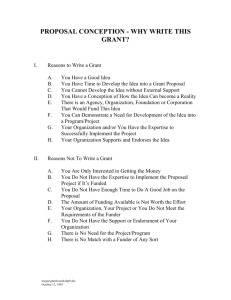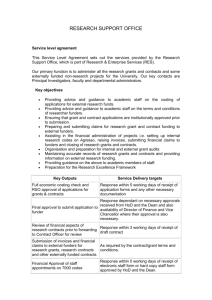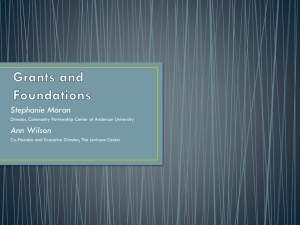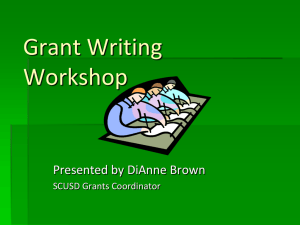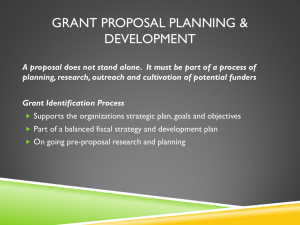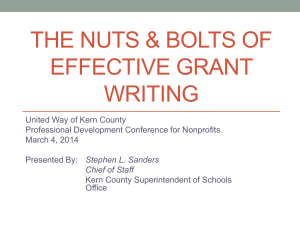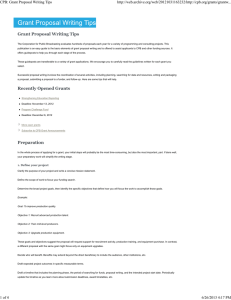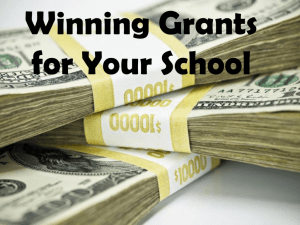capital & access to capital
advertisement
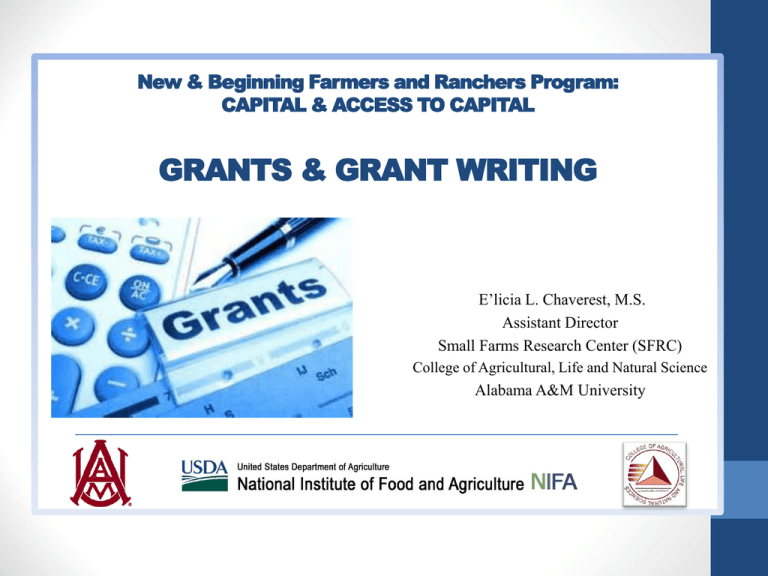
New & Beginning Farmers and Ranchers Program: CAPITAL & ACCESS TO CAPITAL GRANTS & GRANT WRITING E’licia L. Chaverest, M.S. Assistant Director Small Farms Research Center (SFRC) College of Agricultural, Life and Natural Science Alabama A&M University CAPITAL AND ACCESS CAPITAL Capital is different from money. Money is used simply to purchase goods and services for consumption. Capital is more durable and is used to generate wealth through investment. Capital refers to financial resources available for use. Grants vs. Loans GRANTS—You do not have to payback LOANS-You have to PAYBACK eventually LET’S FOCUS ON GRANTS Define Grants are non-repayable funds disbursed by one party (grant makers), often a government department, corporation, foundation or trust, to a recipient, often (but not always) a nonprofit entity, educational institution, business or an individual. In order to receive a grant, some form of "Grant Writing" often referred to as either a proposal or an application is required. Simple: You do not have to payback Reference: http://en.wikipedia.org/wiki/Grant_(money) GRANTS AVAILABLE • The Awesome Foundation Grant—Initiated in 2009. A series of monthly $1,000 grants to projects and their creators. The money is pooled together from the coffers of ten or so self-organizing “micro-trustees” and given upfront in cash, check, or gold doubloons. • SSAWG Grants-2014 Farmer Rancher Grant • Alabama Forestry Forever Grant Quality of life & stewardship of the land. • ALA-Tom Resource Conservation and Development (RC & D) Council • USDA Rural Development Value-Added Producers Grant GRANT WRITING “Money comes when you do what your are good at it and your work hard at it” Unknown I. PROPOSAL PLANNING • Brainstorming ideas, methods • Seeking appropriate funding sources • Researching the proposed topic BRAINSTORMING • Involve appropriate representative from each participating organization • Generate, record, clarify and vote on ideas; keep accurate notes of discussion • Define specific project • Identify lead organization; delegate tasks and responsibilities • Develop timeline to meet submission BRAINSTORMING TIPS • Focus on solutions to issues and change; not attainment of grants funds • The more innovative/ unique, the greater likelihood it will catch funder’s attention • Notes from brainstorming will be useful during proposal development stage SEEKING APPROPRIATE FUNDERS • Peruse funding source publications • Match focus of project needs with funding source’s priorities • Call and request additional information • Annual report guidelines • Information brochure • Request to be added to mailing list SEEKING APPROPRIATE FUNDERS • Review past grantees in annual report for: • • • • Type of organization Geographic area Level of funding Similar projects -Establish funding source files -Define project SEEKING APPROPRIATE FUNDERS • Prepare project outline • • • • • • • Participating organizations How project meets funders priorities Why project is unique/important Planning completed to date Activities to be implemented Intended outcomes/accomplishments Level of anticipated budgets SEEKING APPROPRIATE FUNDERS • Contact program officer to discuss project • By phone- use outline • In writing- cover letter and two page project summary • By visit- forward project summary, send letter confirming visit, be prepared to discuss project in detail. TIPS-FUNDING SOURCES • Contact with funders increases your chances of being funded by 100% • first impressions are critical • Write proposal with particular funding source in mind • Notify all solicited funders of other potential funders • Review proposals of other projects the funder has funded • Use funders “buzz words” to your benefit • Know funder’s review and decision timeline RESEARCHING THE PROJECT TOPIC • Use magazines, newspaper etc. to perform manual and on-line literature searches • Review relevant literature, highlighting important segments; begin bibliography • Contact experts in the field • Contact agencies previously funded • Establish implementation file LET’S USE AN EXAMPLE LET’S DISCUSS! VALUE ADDED- AGRICULTURAL PRODUCTS Definition: Adding value to product. ASSIGNMENT #1 • Establish group of (2 or 3) • Develop an farm -( ie. GreenHouse Farm) • Choose a agricultural value-added product (ie. Organic homemade jams and jellies) • Choose a spokesman representation • Choose one writer II. PROPOSAL DEVELOMENT • Check funders guidelines for: • Defined format • Type style, size, spacing • Binding requirements • Avoid jargon • Use brainstorming notes GOALS & OBJECTIVES • Goals desired end results • Broad conceptual statements • Do not exceed (4) main goals • Begins with the word “to” • Objectives: activities to achieve results • Specific, measurable, compatible, achievable • Do not exceed (6) objectives per goal • Begin with action word (e.g.: develop) PROJECT SUMMARY: Concise Overview • • • • • • In front of proposal; last piece written PROJECT SUMMARY Two pages or less Identify grant applications(s); lead organization Outline general concepts List expected outcomes Provide general budget figures PREFACE: INTRODUCTION, SIGNATURE • • • • • • • Two pages or less Establishes who is applying for $$$ States mission of project Identifies main themes, concepts States uniqueness of project Name, address, phone of contact person Signature and date Title Page: WHAT, WHO, WHEN • • • • • One page Includes title of project List funding agency List name, address of applicant List date of submission PROBLEM STATEMENT (What are you wanting to do?) • Includes statistical data, results of previous studies, tables, figures, accurate citations, avoid assumptions • Identify other organizations who have addressed this issues • Clearly define problem and focus • Identify beneficiaries • Include impact, outcomes METHODOLOGY: How implemented • Introduction • Uniqueness is stated • Expertise of submitting agency/agencies • Background of participating groups • When, why formed, mission, goals • Description of previous projects • Appendix of organizational chart, summaries of grants, contracts, etc…… METHODOLOGY: How Implemented • Roles of participating groups • Identify lead organization • Define roles of other groups • Project description • Activities outlined step by step • May include site selection criteria, participants identification, training process curriculum, outreach activities, needs assessment, information dissemination, future funding GOVERNANCE, MANAGEMENT, & STAFF • Identify lead organization, subcontract arrangements, funding flow • Board member and/or advisory group composition, frequency of meetings, role and authority of Board/advisory group • Identify persons responsible for project, title, time contributed to project, expertise; resumes in appendix • Include table summarizing staffing PROJECT TIMELINE • Table form; very limited narrative • Time increments across top, specific activities under appropriate headings • If symbols are used, provide key to symbols EVALUATION • Who will perform evaluation (internal or external)? • Type of evaluation • Process and/or outcome • Quantitative and/or qualitative • Plan for evaluation project • Clearly define success criteria • Identify data gathering methods • How assess process, context, and outcomes BUDGET: Costs, funding sources • Follow format of funding agency • Try not over budget or under budget • Include all costs related to project activities • Personnel cost (salaries and fringes are separate line items) • Operational costs (supplies, travel, communication, office) • Evaluation costs • Indirect costs (if allowed) BUDGET: Costs, funding sources • Use tables, charts, graphs to display budget requirements • Include budget summary (numbers) and budget narrative BUDGET NARRATIVE: Explains budget • How many organizations are contributing funding; percentage from each • How were budget figures determined • Year funding, will peak, and why • Salary increases included, how fringe benefits calculated BUDGET NARRATIVE: Explains budget • • • • Subcontracts may be involved Most grants, ask for matching funds Difference between In-kind contributions vs. Monetary funds? Continuation beyond initial funding Question? Sustainability and Economical APPENDICES: Supplemental Information • 501 (c) (3) Tax exempt status letter • Resumes of project staff--BIO/VITAE/RESUME • Letters of support-How will you be supportive of the project • Responsibilities Or duties pertaining to project • Provide what kind of assistance APPENDICES: Supplemental Information (cont.) Note: RE-READ Announcement • Organizational charts • List of current, past projects • Survey instruments to be used • Bibliography of references PROPOSAL REVIEW • Identify at least one person not involved with the project to proof read the proposal. Look for: • • • • Typographical, formatting, grammatical errors Clarify, jargon Flow, “leaps of faith” Overall content LET’S USE AN EXAMPLE LET’S DISCUSS! Assignment #2 • What are you wanting to do? • Goals & Objective • Methodology/ImplementationBackground Information -Past experience -Who will assist you AND in what capacity? (i.e. Alabama Cooperative Extension System) • How much are you asking for, Budget? Usage of funds? • Sustainability and Economic Impacts MODIFICATIONS • Include reviewers comments • One final check for: • Correct page numbering, referencing of tables, charts, etc… • No typographical, grammatical or formatting errors • Proper layout, consistent margins, print type • Neatness SUBMISSION • Re-check for deadlines!!!! • Review proposal according to instructions on how and where it should be submitted (i.e., electronically, and delivered by 5:00p.m. on November 15th) • Make appropriate number of copies for submission to funder, for partnering groups • Re-read requirement how the proposal need to be submitted—I.e., Send all copies in one box/envelope; use return receipts requested • File (USB DRIVE & Print) DEVELOPMENT TIPS • Proposal should appear as though one person wrote it; one person responsible for coordinating proposal development • Determine whether letters of support or commitment are needed; they are different • Allow sufficient time for all involved parties to review proposal before submission III. PROPOSAL FOLLOW-UP What happens to a proposal after it is submitted? • Post submission follow-up with funder • Site visits • Once funding, decisions are made POST-SUBMISSION FOLLOW-UP • About 1 week after submission, contact funding agency to ask • Did proposal arrive • Any further information required • Confirm time line for review of proposals, decision date (Arbitrary, It depends on the agency. Always read the fine print. ie. Respect their wishes) SITE VISITS • Be prepared, know grant completely, have supplemental material available • Know budget and how figures were determined • Talk with funder regarding length of site visit, persons to participate, any specific requests • Send thank you after the visit Once funding decision made • • • • Successful funding decision Rewrite Seeking other funding sources Reassess viability of project !!!FIVE MINUTE BREAK!!! IV. SUCCESSFUL FUNDING • Familiarize yourself with report deadlines (narrative and fiscal) • Determine who is responsible for media notification • Forward letter announcing award to participating groups, others who participated in proposal developement SUCCESSFUL FUNDING • • • • Keep funder informed or progress, problems successes Clarify process for budget or process revisions Keep accurate, separate financial records of grant funding Pay as much attention to the project’s implementation as you did to its development REWRITE • Write funding agency, determine which sections need modifications • If methodology change, does it require begin changes also • If funder suggests reducing budget, can project still be accomplished at its established focus? SEEKING OTHER FUNDING SOURCES • Review funding sources for other matches between project and funder’s priorities; select new funding source • Get funding source information, visit with funding source program staff • Make modifications in proposal with new funding source in mind • Meet new submission deadline and guidelines REASSESS FUNDING VIABILITY • • • • Is proposal outdated due to time lapse? Has environment changed? Have resources been modified? Have priorities changed? FOLLOW-UP TIPS • If funding is turned down twice, try again • Ask for feedback on why proposal wasn’t funded • Be patient; funding decisions can take from a few weeks to a year or more • Acknowledge rejections with thank you for consideration SUMMARY OF TIPS FOR A SUCCESS GRANT • Read requirements • Check the deadline • Make contact with funding agency • Begin writing (Start-Up Action Plan) • Delegate responsibilities • Utilize and consult with funding agency, Small Business Administration, organizations and universities • Budgeting-Do not be too greedy.. penalize • Review proposal & FOLLOW DIRECTIONS! • Submit on time • Finally, hope for the best, be prepared for worse (Possible rejection.) BE READY TO WORK & DELIVER! • Be Resilient (Try, try again.) SUMMARY OF TIPS FOR A SUCCESS GRANT (cont.) REMEMBER: “Amateurs built the arch, while professionals built the Titanic" Unknown REFERENCES • Mashall, Maria. Writing a Successful Grant Proposal. Agricultural Innovation & Commercialization Center. Purdue University. • Trechter, David . Cooperative Development Initiative. University of Wisconsin. Grant Writing “ Tips for Successful Proposals. 2001. • Kallestinova, Elena, Ph.D. How to Write a Winning Abstract for Grant Applications. Graduate School Graduate School Writing Center. • Dolcini., Val. Commentary: Microloans expand access to capital for small farmers. February 27, 2013 • Lewis, Hannah. Financing Your Farm: Guidance for Beginning Farmers. October. 2011 www.attra.ncat.org • Penn State. Financing Small Scale and Part-time Farms, Agricultural Alternatives.agalternatives.aers.psu.edu • Investopedia.com • Mundende, D.Chongo, Ph.D. How to Achieve your Goal presentation. Small Farms Research Center (AAMU) RM & Business Development Training Workshop Mobile, Alabama • Yahoo.com for Images
